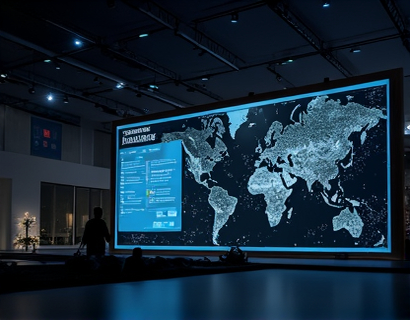Next-Gen QR Code Technology: Elevating Business and Social Media Engagement for Modern Brands
In the rapidly evolving digital landscape, businesses are constantly seeking innovative ways to engage with their audience. One of the most transformative tools that has emerged in recent years is the next-generation QR code technology. This advanced form of QR code redefines how brands interact with customers, offering customizable and intuitive solutions that streamline information sharing and enhance customer interaction. As businesses strive to enhance their digital presence and foster deeper connections with their audience, understanding the capabilities and benefits of next-gen QR codes becomes essential.
The Evolution of QR Codes
QR codes, or Quick Response codes, were first developed in 1994 for the automotive industry in Japan. Initially, they served as a means to track vehicle parts during manufacturing. However, with the advent of smartphones and mobile technology, QR codes found their way into the consumer market, allowing users to access information quickly and efficiently. Traditional QR codes typically contained static information, such as URLs or text, limiting their functionality and engagement potential.
Next-gen QR codes have evolved significantly, incorporating advanced features that enhance user experience and engagement. These modern codes are not only customizable but also dynamic, allowing businesses to change the information linked to the code without altering the code itself. This flexibility is crucial for brands looking to adapt their marketing strategies in real-time.
Customizable Features of Next-Gen QR Codes
One of the standout features of next-gen QR codes is their customization options. Businesses can design QR codes that align with their branding, incorporating colors, logos, and unique shapes. This level of personalization not only makes the codes visually appealing but also reinforces brand identity. For instance, a restaurant can create a QR code in the shape of a fork or knife, while a tech company might opt for a sleek, modern design that reflects its innovative ethos.
Moreover, next-gen QR codes can be embedded with various types of content, including videos, images, and interactive elements. This capability allows brands to create immersive experiences for their audience. For example, a fashion retailer can link a QR code to a video showcasing a new clothing line, while a real estate agency might use it to provide virtual tours of properties. By offering rich content, businesses can capture the attention of potential customers and encourage them to engage further.
Streamlining Information Sharing
In today's fast-paced world, consumers expect quick access to information. Next-gen QR codes facilitate this by providing a seamless way to share details about products, services, and promotions. Instead of manually typing in URLs or searching for information online, users can simply scan a QR code with their smartphone, instantly accessing the desired content.
This streamlined approach is particularly beneficial for businesses during events, promotions, or product launches. For instance, a company hosting a trade show can place QR codes on banners or brochures, allowing attendees to quickly access product information, sign up for newsletters, or follow the brand on social media. This not only enhances the attendee experience but also increases the likelihood of conversion.
Boosting Customer Interaction
Next-gen QR codes are not just about information sharing; they also play a crucial role in boosting customer interaction. By integrating interactive elements into QR codes, businesses can create engaging experiences that encourage users to take action. For example, a restaurant can use a QR code to offer a discount on the next meal when scanned, incentivizing customers to return. Similarly, a brand can create a QR code that leads to a survey or feedback form, allowing customers to share their opinions and experiences.
Furthermore, next-gen QR codes can be linked to social media platforms, enabling users to follow, like, or share content with a simple scan. This integration is particularly valuable for brands looking to expand their social media presence and engage with their audience on multiple platforms. By making it easy for customers to connect with them online, businesses can foster a sense of community and loyalty.
Enhancing Marketing Campaigns
Next-gen QR codes can significantly enhance marketing campaigns by providing measurable results and insights. Businesses can track the performance of their QR codes, analyzing data such as scan rates, user demographics, and engagement levels. This information is invaluable for refining marketing strategies and understanding customer behavior.
For instance, a brand running a promotional campaign can create unique QR codes for different channels, such as print ads, social media, and email newsletters. By comparing the performance of each code, the brand can identify which channels are most effective in driving engagement and conversions. This data-driven approach allows businesses to allocate resources more efficiently and optimize their marketing efforts.
Case Studies: Successful Implementation of Next-Gen QR Codes
To illustrate the impact of next-gen QR codes on business and social media engagement, let’s explore a few case studies of brands that have successfully implemented this technology.
Case Study 1: Retail Brand
A well-known retail brand launched a campaign to promote its new line of eco-friendly products. They created customized QR codes that were placed on product packaging, in-store displays, and online advertisements. When scanned, the QR codes directed customers to a dedicated landing page featuring videos about the products' sustainability, customer testimonials, and a special discount for first-time buyers. The campaign resulted in a 30% increase in sales for the eco-friendly line and a significant boost in social media engagement, with many customers sharing their experiences online.
Case Study 2: Restaurant
A local restaurant sought to enhance its customer experience by implementing next-gen QR codes for its menu. Instead of traditional printed menus, customers could scan a QR code at their table to view the menu on their smartphones. The digital menu included high-quality images, detailed descriptions, and the option to place orders directly from their devices. This innovation not only improved the dining experience but also reduced wait times, leading to higher customer satisfaction and repeat visits.
Case Study 3: Event Management
An event management company utilized next-gen QR codes for a large conference. They created unique QR codes for each session, allowing attendees to scan and access session details, speaker bios, and presentation materials. Additionally, the QR codes linked to social media platforms, encouraging attendees to share their experiences in real-time. The event saw a significant increase in social media mentions and engagement, with attendees actively participating in discussions online.
Challenges and Considerations
While next-gen QR codes offer numerous benefits, businesses must also consider potential challenges. One of the primary concerns is ensuring that customers are familiar with how to use QR codes. Although smartphone penetration is high, not all consumers may be comfortable scanning codes. Therefore, businesses should provide clear instructions and promote the use of QR codes through various channels.
Another consideration is the need for reliable internet connectivity. QR codes often link to online content, and if users are in an area with poor connectivity, they may not be able to access the information. Businesses should consider offering offline alternatives or ensuring that the linked content is accessible without a strong internet connection.
The Future of QR Code Technology
As technology continues to advance, the future of QR codes looks promising. Innovations such as augmented reality (AR) and artificial intelligence (AI) are likely to play a significant role in the evolution of QR codes. For instance, businesses may soon be able to create AR experiences that users can access by scanning a QR code, providing an even more immersive and interactive experience.
Additionally, as consumer behavior shifts towards contactless interactions, the demand for QR codes is expected to grow. The COVID-19 pandemic accelerated the adoption of contactless solutions, and QR codes have become a preferred method for accessing information without physical contact. This trend is likely to continue, making next-gen QR codes an essential tool for businesses looking to adapt to changing consumer preferences.
Conclusion
Next-gen QR code technology is revolutionizing the way businesses engage with their audience. By offering customizable, intuitive solutions that streamline information sharing and boost customer interaction, these advanced codes are essential for brands looking to enhance their digital presence. As businesses continue to explore innovative ways to connect with their customers, next-gen QR codes will undoubtedly play a pivotal role in shaping the future of marketing and engagement strategies. Embracing this technology not only allows brands to stay ahead of the competition but also fosters deeper connections with their audience, ultimately driving growth and success in the modern digital landscape.










































